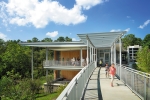Living Building for All
>
After more than a year of extensive testing and documentation, the Frick Environmental Center (FEC), Pittsburgh, United States, has achieved prestigious Living Building certification, the world’s most rigorous proven performance standard by the International Living Future Institute. Designed by renowned architecture firm Bohlin Cywinski Jackson, the FEC is the first Living Building in the U.S. that is municipally owned and free and open to the public.
The FEC is one of only 21 buildings in the world to achieve Living Building-certification; the facility is the second certified in Pittsburgh and Pennsylvania, sharing the honor with the Phipps Center for Sustainable Landscapes. However, the center is the first building to meet the Living Building Challenge designation under v2.1. To qualify, the building must produce as much energy as it consumes annually, eliminate toxic and harmful chemicals, and collect and treat its own water.
“The international recognition of the Frick Environmental Center is the perfect reflection of the deeply-rooted convictions shared by the City of Pittsburgh, the Parks Conservancy, and the entire construction and design team,” said Patricia Culley, Bohlin Cywinski Jackson senior associate and FEC project architect.
Completed in 2016, the 16,000-square-foot center was certified LEED Platinum by the U.S. Green Building Council in December 2017, received an Award of Excellence from AIA Committee on Education in April, and recognized with a Leadership Award by the Green Building Alliance last fall for its role in a decade-long vision of incorporating the world’s highest sustainability standards into a free, public, municipally owned building.
Bohlin Cywinski Jackson collaborated with the Pittsburgh Parks Conservancy, the City of Pittsburgh, construction manager PJ Dick, and landscape architects LaQuatra Bonci to bring the environmental center to life. Made possible via donations and a community-based process that began in 2011, the facility allows students of all ages to partake in environmental classes, events, and programs. It also acts as a gateway to the 644-acre Frick Park, encouraging visitors to experience the surrounding landscape.
Bohlin Cywinski Jackson


